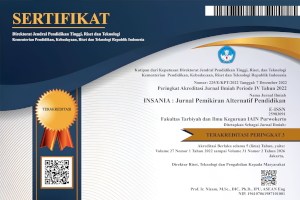Integrasi-interkoneksi Sains Islam pada Mata Kuliah Antropobiologi
DOI:
https://doi.org/10.24090/insania.v26i1.4747Keywords:
anthropobiology, integration-interconnection, Islam, scienceAbstract
Islamic Higher Education (PTAI) is expected to be a research based university with international competitiveness without losing its characteristics. It is necessary to eliminate the scientific dichotomy by integrating science with Islamic religious studies. At IAIN Purwokerto, the concept of integration-interconnection is manifested in “Jabalul Hikmah”. The epistemological reintegration of the scientific foundations is expected to answer academic, religious, social, cultural, and technological problems in society. One of the subjects based on general science which needs to be integrated with Islamic studies is Anthropobiology. Hence, this study aims to examine how to present anthropobiology courses in an integrated interconnected with Islamic studies. This research is a library research conducted by collecting and analyzing data from books, journals, and articles related to scientific integration models and anthropobiological concepts in pure science and Islamic perspectives. In the Miles and Huberman model, the collected will be reduced to focus on the important things, then the data is presented, and finally verified. The results show that efforts to integrate Islamic science in Anthropobiology course material can be done by integrating anthropobiological concepts derived from universal truths with Islamic studies. Through the integration-interconnection of Islamic science, Anthropobiology courses can support Islamic Early Childhood Education Study Program students to have a comprehensive understanding of human characteristics to prepare early childhood education.Downloads
References
Abdullah, A., Mulkhan, Munir, A., Machasin, Asy'arie, M., Nasution, K., Ilyas, H., & Faiz, F. (2014). Praksis Paradigma Integrasi-Interkoneksi dan Transformasi Islamic Studies di UIN Sunan Kalijaga.
Amril. (2018). Nilainisasi Pembelajaran Sains (Upaya Pembelajaran Integrasi-Interkoneksi Agama dan Sains). Journal of Natural Science and Integration, 1(2), 133-144. http://dx.doi.org/10.24014/jnsi.v1i2.6593
Ansharullah. (2016). Kajian Tingkat Pemahaman Konsep Integrasi Ilmudan Islam antara Dosen Bidang Ilmu Umum dengan Dosen Bidang Ilmu Agama di Fakultas Ilmu Tarbiyah dan Keguruan UIN Syarif Hidayatullah Jakarta. Potensia: Jurnal Kependidikan Islam, 2(1), 71-84. http://dx.doi.org/10.24014/potensia.v2i1.2532
Arifudin, I. (2016). Integrasi Sains dan Agama serta Implikasinya terhadap Pendidikan Islam. Edukasia Islamica: Jurnal Pendidikan Islam, 1(1), 161-179. https://doi.org/10.21927/literasi.2013.4(2).171-188
Bagir, Z. A. (2005). Integrasi Ilmu dan Agama, Interpretasi dan Aksi. Mizan.
Batubara, H. H. (2018). Metode dan Model Integrasi Sains dan Islam di Perguruan Tinggi Agama Islam. Preprint, 1-18. https://doi.org/10.13140/ RG.2.2.24112.66563
Creswell, J. W. (2019). Research Design: Pendekatan Metode Kualitatif, Kuantitatif, dan Campuran. Pustaka Pelajar.
IAIN Purwokerto. (2020). Panduan Akademik Program Strata 1 (S.1) IAIN Purwokerto
Kholil, A. (2009). Integrasi Sains dan Agama Dalam Perspektif Etika. Ulul Albab Jurnal Studi Islam, 10(1), 107-128. https://doi.org/10.18860/ua.v10i1.6071
Lajnah Pentashihan Mushaf Al-Qur'an . (2016). Penciptaan Manusia dalam Perspektif Al Qur'an dan Sains. Lajnah Pentashihan Mushaf Al-Qur'an .
Lieberman, L. S. (n.d.). Human Biology within The Framework of Physical Anthropology. Encyclopedia of Life Support Systems (EOLSS). http://eolss.net/ Sample-Chapters/C03/E6-20A-0b.pdf
Mas'ud, A. (2007). Menggagas Format Pendidikan Nondikotomik. Gama Media.
Musi, M. H. (2020). Antropobiologi Anak Usia Dini. Kencana.
Nelson, K., Braff, L., Shook, B., & Aguilera, K. (2019). 1. Introduction to Biological Anthropology. In Explorations: An open Invitation to Biological Anthropobiology (pp. 1-27). American Anthropological Association.
Indonesia. Kemdikbud. (2014). Permendikbud No. 49 Tahun 2014 tentang Standar Nasional Pendidikan Tinggi. https://lldikti12.ristekdikti.go.id/2014/06/ 11/pemendikbud-no-49-tahun-2014-tentang-standar-nasional-pendidikan-tinggi.html
Qadir, M. H. Abd. (2019). Integralisasi Ilmu Pengetahuan Upaya Konversi IAIN menjadi UIN. Cendekia?: Jurnal Studi Keislaman, 5(1), 141-154. https://doi.org/ 10.37348/cendekia.v5i1.69
Rahma, A. (2017). Peranan Bioantropologi bagi Pendidikan Guru Pendidikan Anak Usia Dini. Jurnal Ilmiah Kependidikan Literat, n.v.(n.i.), 34-41.
Rosadisastra, A. (2014). Integrasi Ilmu Sosial dengan Teks Agama dalam Perspektif Tafsir Al-Qur'an. Mutawatir: Jurnal Keilmuan Tafsir Hadith, 4(1), 87-116. https://doi.org/10.15642/mutawatir.2014.4.1.87-116
Sari, M., & Asmendri. (2020). Penelitian Kepustakaan (Library Research) dalam Penelitian Pendidikan IPA. Natural Science: Jurnal Penelitian Bidang IPA dan Pendidikan IPA, 6(1), 41-53. https://doi.org/10.15548/nsc.v6i1.1555
Sugiyono. (2017). Metode Penelitian Kualitatif. Alfabeta.
Suprayogo. (2019). Universitas Islam Unggul: Refleksi Pemikiran Pengembangan Kelembagaan dan Reformulasi Paradigma Keilmuan Islam. UIN Press.
Zain, Z., & Vebrianto, R. (Mei, 2017). Integrasi Keilmuan Sains dan Islam Dalam Proses Pembelajaran Rumpun IPA [Paper Presentation]. In Seminar Nasional Teknologi Informasi, Komunikasi Dan Industri (SNTIKI) 9, Pekanbaru (pp. 18-19). UIN Sultan Syarif Kasim Riau.
Downloads
Additional Files
Published
How to Cite
Issue
Section
License
Authors who publish with this journal agree to the following terms:
Authors retain copyright and grant the journal right of first publication with the work simultaneously licensed under a Creative CommonsAttribution-ShareAlike License that allows others to share the work with an acknowledgment of the work's authorship and initial publication in this journal.
Authors are able to enter into separate, additional contractual arrangements for the non-exclusive distribution of the journal's published version of the work (e.g., post it to an institutional repository or publish it in a book), with an acknowledgment of its initial publication in this journal.
Authors are permitted and encouraged to post their work online (e.g., in institutional repositories or on their website) prior to and during the submission process, as it can lead to productive exchanges, as well as earlier and greater citation of published work (See The Effect of Open Access).









